Finance for Managers: Financial Analysis and Investment Appraisal
VerifiedAdded on 2023/01/06
|15
|3869
|39
Report
AI Summary
This report, titled "Finance for Managers," delves into crucial aspects of financial management. It begins with an introduction to financial analysis, emphasizing the significance of data sources both internal and external to an organization. The report then performs a detailed ratio analysis of Unilever plc, assessing its profitability, efficiency, liquidity, and gearing ratios. Following this, it explores various budgeting approaches, including input/output, activity-based, and incremental budgeting, considering financial constraints, organizational targets, accounting conventions, and legal requirements. Furthermore, the report discusses cash flow issues and legal requirements related to budgeting, providing insights into effective resource allocation. Finally, it examines investment appraisal techniques, offering a comprehensive overview of financial management principles and their practical application. The report uses financial statements, ratio analysis, and budgeting techniques to assess organizational performance and guide financial decision-making.
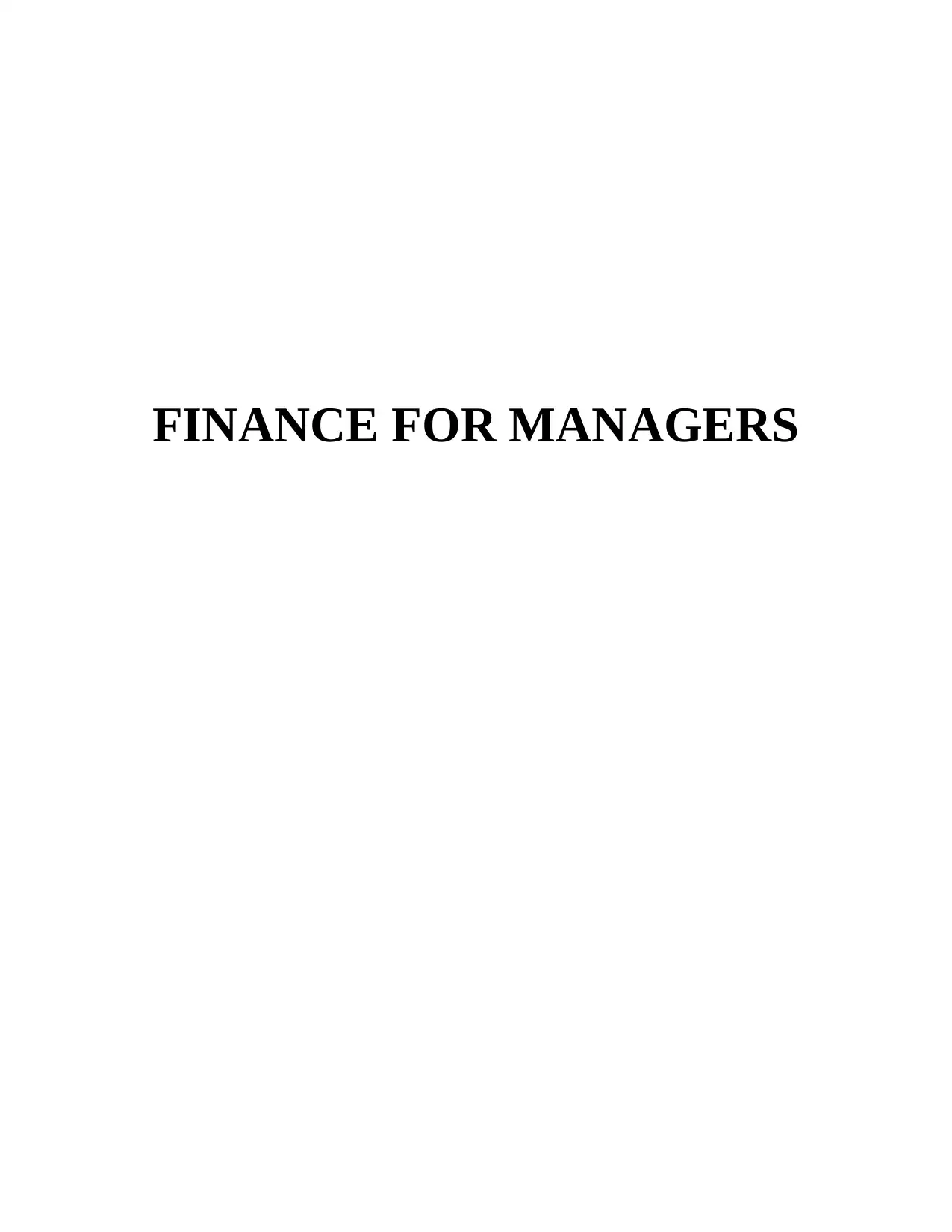
FINANCE FOR MANAGERS
Paraphrase This Document
Need a fresh take? Get an instant paraphrase of this document with our AI Paraphraser
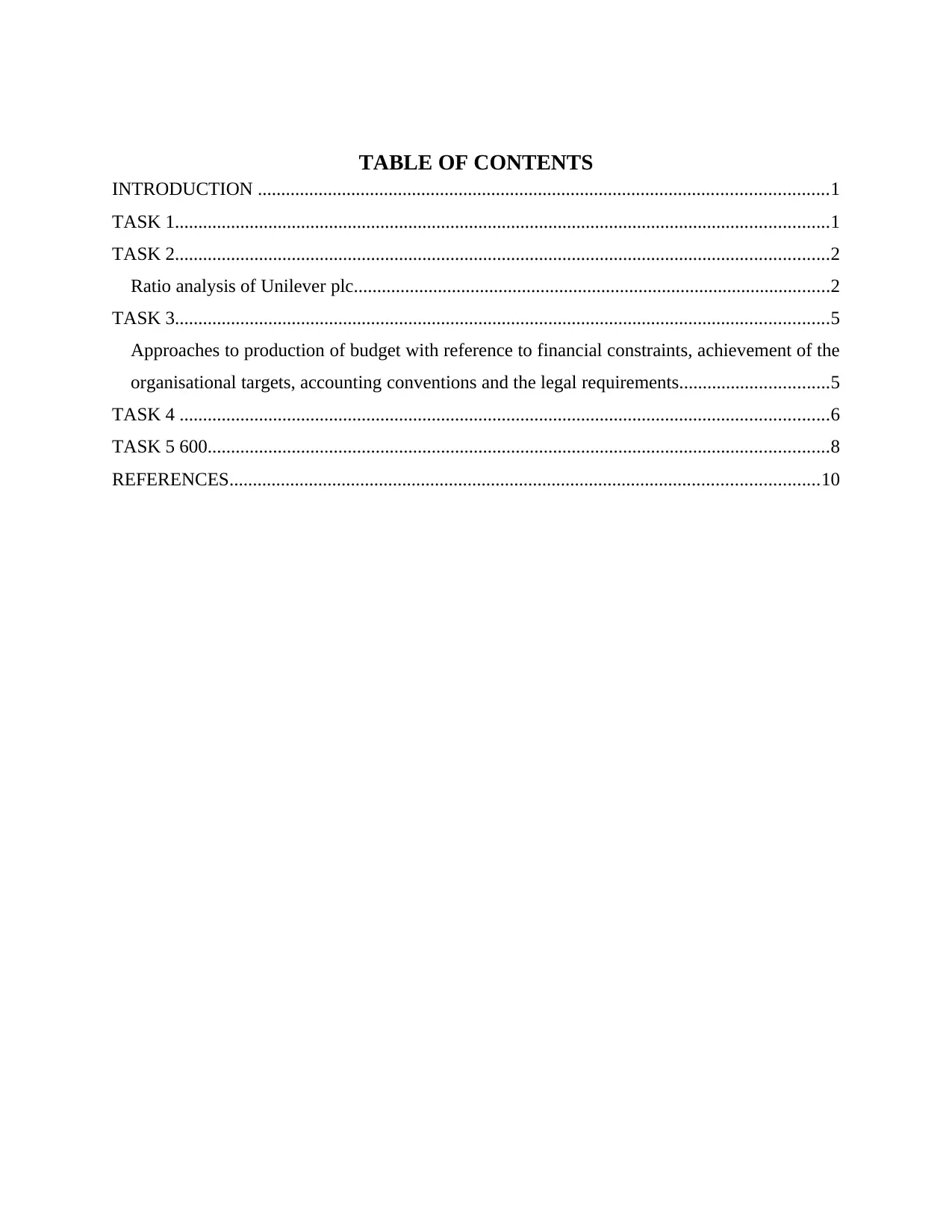
TABLE OF CONTENTS
INTRODUCTION ..........................................................................................................................1
TASK 1............................................................................................................................................1
TASK 2............................................................................................................................................2
Ratio analysis of Unilever plc......................................................................................................2
TASK 3............................................................................................................................................5
Approaches to production of budget with reference to financial constraints, achievement of the
organisational targets, accounting conventions and the legal requirements................................5
TASK 4 ...........................................................................................................................................6
TASK 5 600.....................................................................................................................................8
REFERENCES..............................................................................................................................10
INTRODUCTION ..........................................................................................................................1
TASK 1............................................................................................................................................1
TASK 2............................................................................................................................................2
Ratio analysis of Unilever plc......................................................................................................2
TASK 3............................................................................................................................................5
Approaches to production of budget with reference to financial constraints, achievement of the
organisational targets, accounting conventions and the legal requirements................................5
TASK 4 ...........................................................................................................................................6
TASK 5 600.....................................................................................................................................8
REFERENCES..............................................................................................................................10
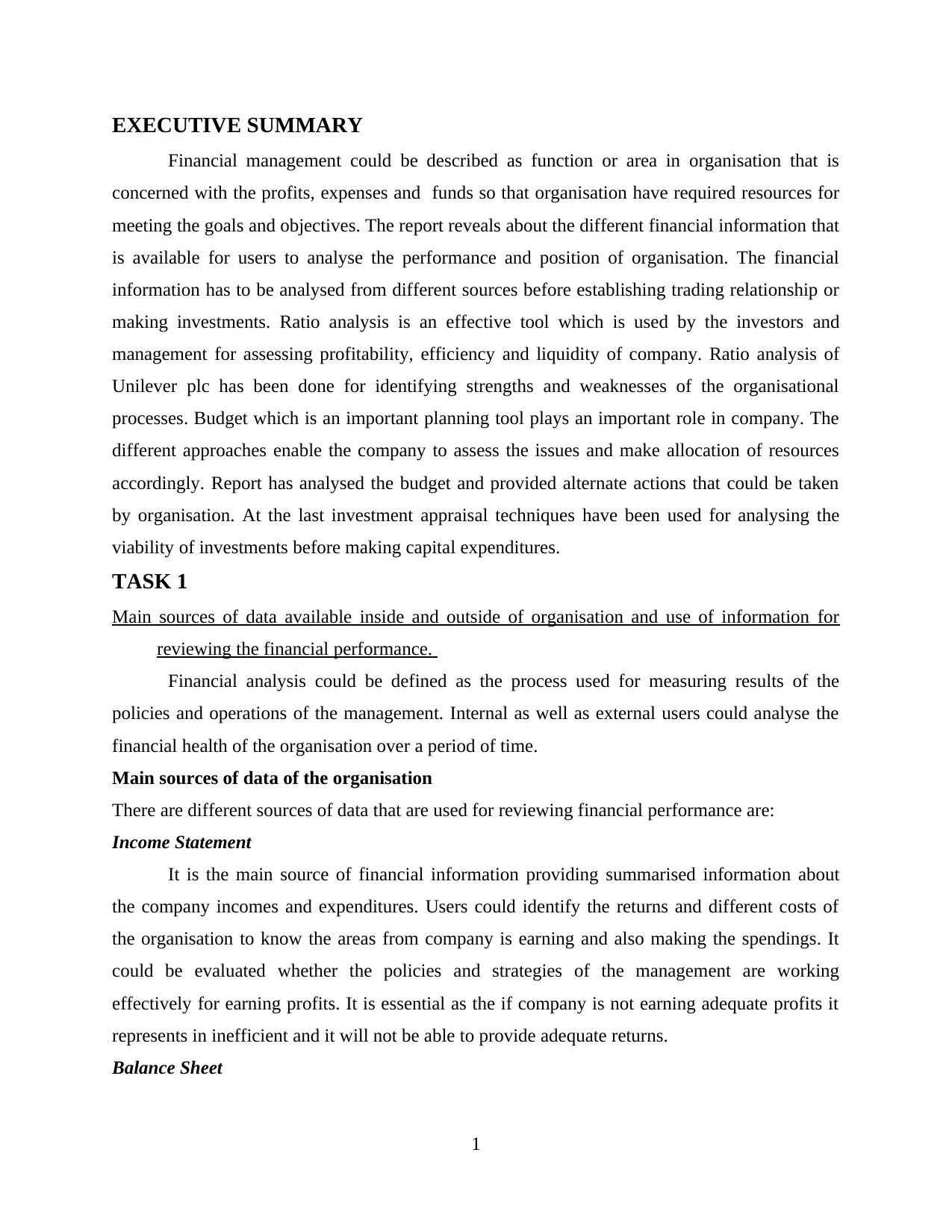
EXECUTIVE SUMMARY
Financial management could be described as function or area in organisation that is
concerned with the profits, expenses and funds so that organisation have required resources for
meeting the goals and objectives. The report reveals about the different financial information that
is available for users to analyse the performance and position of organisation. The financial
information has to be analysed from different sources before establishing trading relationship or
making investments. Ratio analysis is an effective tool which is used by the investors and
management for assessing profitability, efficiency and liquidity of company. Ratio analysis of
Unilever plc has been done for identifying strengths and weaknesses of the organisational
processes. Budget which is an important planning tool plays an important role in company. The
different approaches enable the company to assess the issues and make allocation of resources
accordingly. Report has analysed the budget and provided alternate actions that could be taken
by organisation. At the last investment appraisal techniques have been used for analysing the
viability of investments before making capital expenditures.
TASK 1
Main sources of data available inside and outside of organisation and use of information for
reviewing the financial performance.
Financial analysis could be defined as the process used for measuring results of the
policies and operations of the management. Internal as well as external users could analyse the
financial health of the organisation over a period of time.
Main sources of data of the organisation
There are different sources of data that are used for reviewing financial performance are:
Income Statement
It is the main source of financial information providing summarised information about
the company incomes and expenditures. Users could identify the returns and different costs of
the organisation to know the areas from company is earning and also making the spendings. It
could be evaluated whether the policies and strategies of the management are working
effectively for earning profits. It is essential as the if company is not earning adequate profits it
represents in inefficient and it will not be able to provide adequate returns.
Balance Sheet
1
Financial management could be described as function or area in organisation that is
concerned with the profits, expenses and funds so that organisation have required resources for
meeting the goals and objectives. The report reveals about the different financial information that
is available for users to analyse the performance and position of organisation. The financial
information has to be analysed from different sources before establishing trading relationship or
making investments. Ratio analysis is an effective tool which is used by the investors and
management for assessing profitability, efficiency and liquidity of company. Ratio analysis of
Unilever plc has been done for identifying strengths and weaknesses of the organisational
processes. Budget which is an important planning tool plays an important role in company. The
different approaches enable the company to assess the issues and make allocation of resources
accordingly. Report has analysed the budget and provided alternate actions that could be taken
by organisation. At the last investment appraisal techniques have been used for analysing the
viability of investments before making capital expenditures.
TASK 1
Main sources of data available inside and outside of organisation and use of information for
reviewing the financial performance.
Financial analysis could be defined as the process used for measuring results of the
policies and operations of the management. Internal as well as external users could analyse the
financial health of the organisation over a period of time.
Main sources of data of the organisation
There are different sources of data that are used for reviewing financial performance are:
Income Statement
It is the main source of financial information providing summarised information about
the company incomes and expenditures. Users could identify the returns and different costs of
the organisation to know the areas from company is earning and also making the spendings. It
could be evaluated whether the policies and strategies of the management are working
effectively for earning profits. It is essential as the if company is not earning adequate profits it
represents in inefficient and it will not be able to provide adequate returns.
Balance Sheet
1
⊘ This is a preview!⊘
Do you want full access?
Subscribe today to unlock all pages.

Trusted by 1+ million students worldwide
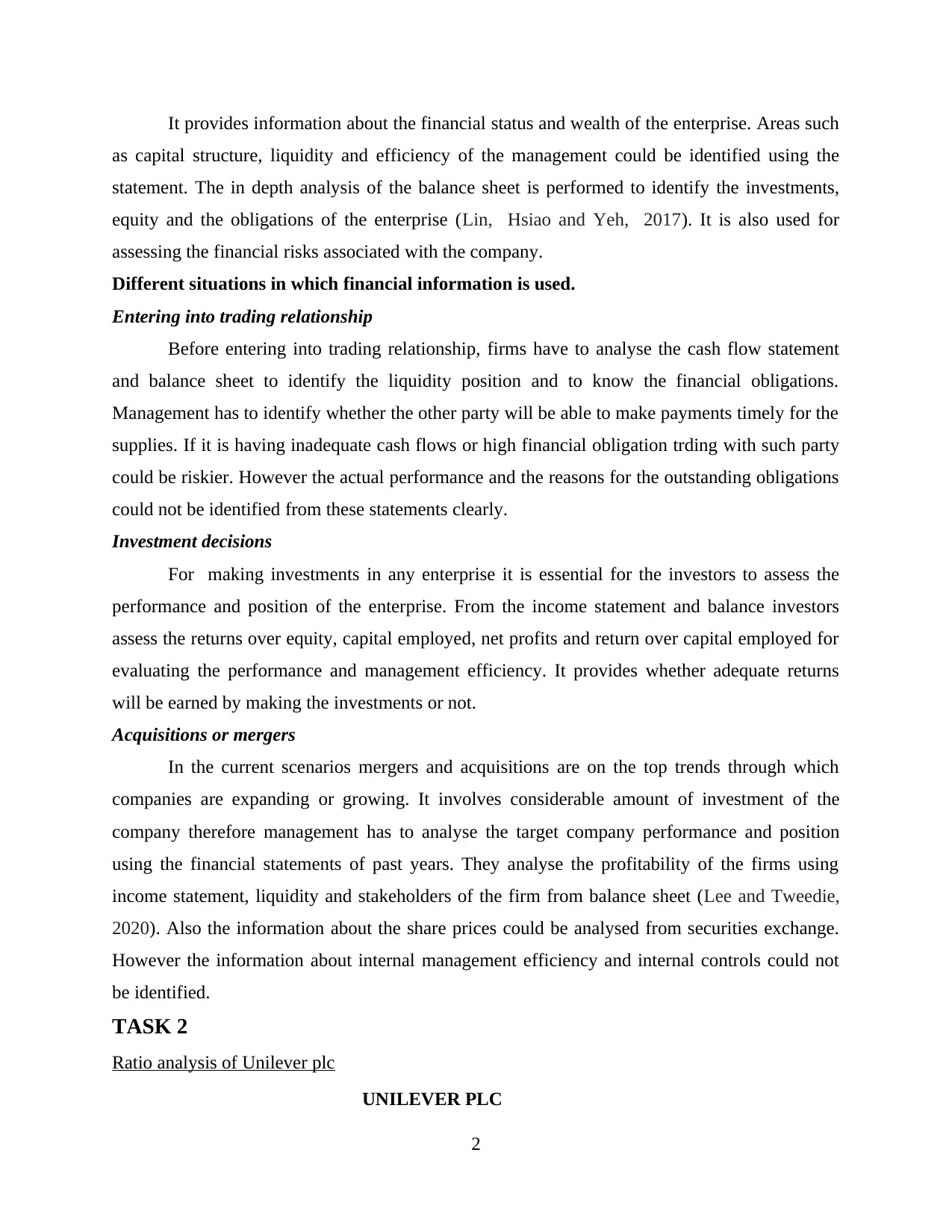
It provides information about the financial status and wealth of the enterprise. Areas such
as capital structure, liquidity and efficiency of the management could be identified using the
statement. The in depth analysis of the balance sheet is performed to identify the investments,
equity and the obligations of the enterprise (Lin, Hsiao and Yeh, 2017). It is also used for
assessing the financial risks associated with the company.
Different situations in which financial information is used.
Entering into trading relationship
Before entering into trading relationship, firms have to analyse the cash flow statement
and balance sheet to identify the liquidity position and to know the financial obligations.
Management has to identify whether the other party will be able to make payments timely for the
supplies. If it is having inadequate cash flows or high financial obligation trding with such party
could be riskier. However the actual performance and the reasons for the outstanding obligations
could not be identified from these statements clearly.
Investment decisions
For making investments in any enterprise it is essential for the investors to assess the
performance and position of the enterprise. From the income statement and balance investors
assess the returns over equity, capital employed, net profits and return over capital employed for
evaluating the performance and management efficiency. It provides whether adequate returns
will be earned by making the investments or not.
Acquisitions or mergers
In the current scenarios mergers and acquisitions are on the top trends through which
companies are expanding or growing. It involves considerable amount of investment of the
company therefore management has to analyse the target company performance and position
using the financial statements of past years. They analyse the profitability of the firms using
income statement, liquidity and stakeholders of the firm from balance sheet (Lee and Tweedie,
2020). Also the information about the share prices could be analysed from securities exchange.
However the information about internal management efficiency and internal controls could not
be identified.
TASK 2
Ratio analysis of Unilever plc
UNILEVER PLC
2
as capital structure, liquidity and efficiency of the management could be identified using the
statement. The in depth analysis of the balance sheet is performed to identify the investments,
equity and the obligations of the enterprise (Lin, Hsiao and Yeh, 2017). It is also used for
assessing the financial risks associated with the company.
Different situations in which financial information is used.
Entering into trading relationship
Before entering into trading relationship, firms have to analyse the cash flow statement
and balance sheet to identify the liquidity position and to know the financial obligations.
Management has to identify whether the other party will be able to make payments timely for the
supplies. If it is having inadequate cash flows or high financial obligation trding with such party
could be riskier. However the actual performance and the reasons for the outstanding obligations
could not be identified from these statements clearly.
Investment decisions
For making investments in any enterprise it is essential for the investors to assess the
performance and position of the enterprise. From the income statement and balance investors
assess the returns over equity, capital employed, net profits and return over capital employed for
evaluating the performance and management efficiency. It provides whether adequate returns
will be earned by making the investments or not.
Acquisitions or mergers
In the current scenarios mergers and acquisitions are on the top trends through which
companies are expanding or growing. It involves considerable amount of investment of the
company therefore management has to analyse the target company performance and position
using the financial statements of past years. They analyse the profitability of the firms using
income statement, liquidity and stakeholders of the firm from balance sheet (Lee and Tweedie,
2020). Also the information about the share prices could be analysed from securities exchange.
However the information about internal management efficiency and internal controls could not
be identified.
TASK 2
Ratio analysis of Unilever plc
UNILEVER PLC
2
Paraphrase This Document
Need a fresh take? Get an instant paraphrase of this document with our AI Paraphraser
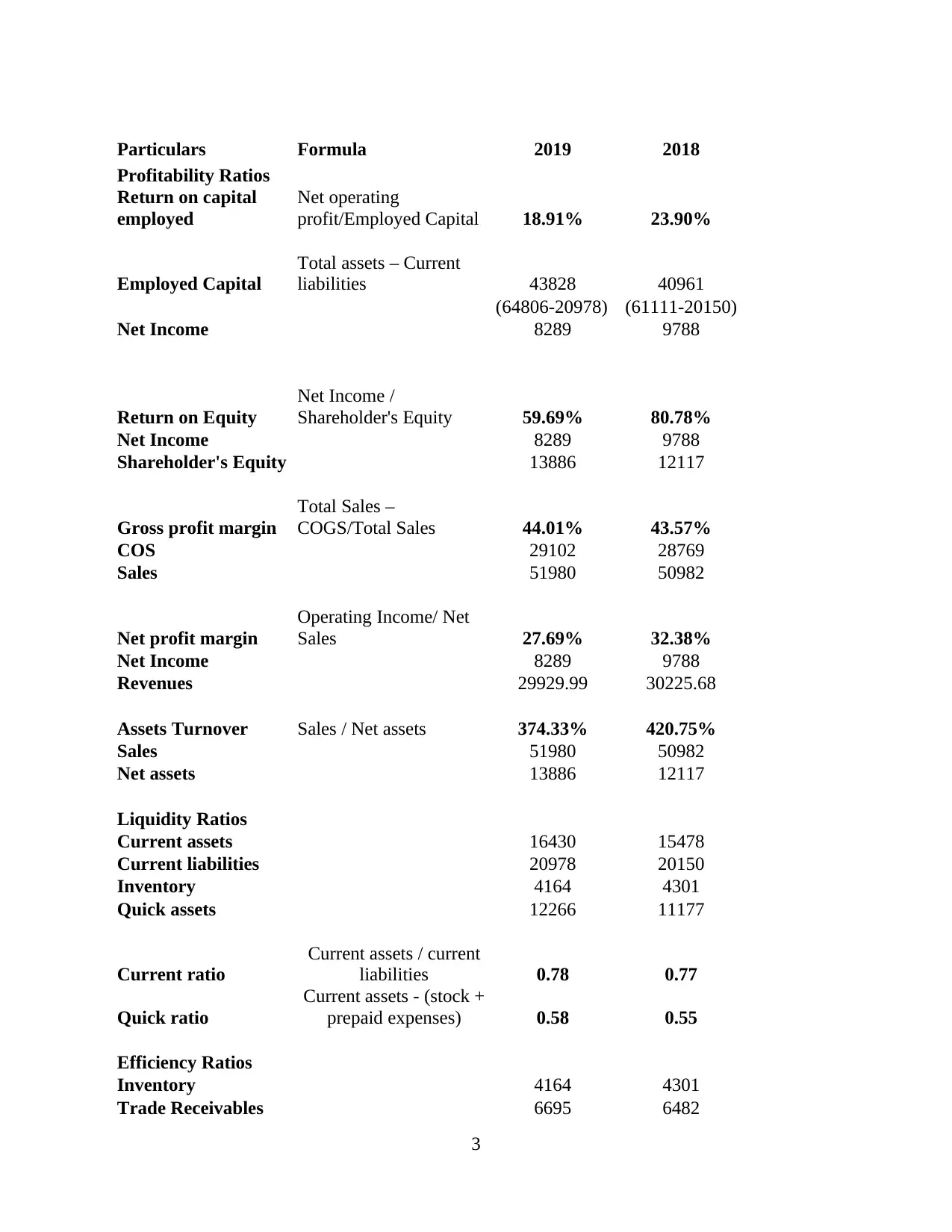
Particulars Formula 2019 2018
Profitability Ratios
Return on capital
employed
Net operating
profit/Employed Capital 18.91% 23.90%
Employed Capital
Total assets – Current
liabilities 43828 40961
(64806-20978) (61111-20150)
Net Income 8289 9788
Return on Equity
Net Income /
Shareholder's Equity 59.69% 80.78%
Net Income 8289 9788
Shareholder's Equity 13886 12117
Gross profit margin
Total Sales –
COGS/Total Sales 44.01% 43.57%
COS 29102 28769
Sales 51980 50982
Net profit margin
Operating Income/ Net
Sales 27.69% 32.38%
Net Income 8289 9788
Revenues 29929.99 30225.68
Assets Turnover Sales / Net assets 374.33% 420.75%
Sales 51980 50982
Net assets 13886 12117
Liquidity Ratios
Current assets 16430 15478
Current liabilities 20978 20150
Inventory 4164 4301
Quick assets 12266 11177
Current ratio
Current assets / current
liabilities 0.78 0.77
Quick ratio
Current assets - (stock +
prepaid expenses) 0.58 0.55
Efficiency Ratios
Inventory 4164 4301
Trade Receivables 6695 6482
3
Profitability Ratios
Return on capital
employed
Net operating
profit/Employed Capital 18.91% 23.90%
Employed Capital
Total assets – Current
liabilities 43828 40961
(64806-20978) (61111-20150)
Net Income 8289 9788
Return on Equity
Net Income /
Shareholder's Equity 59.69% 80.78%
Net Income 8289 9788
Shareholder's Equity 13886 12117
Gross profit margin
Total Sales –
COGS/Total Sales 44.01% 43.57%
COS 29102 28769
Sales 51980 50982
Net profit margin
Operating Income/ Net
Sales 27.69% 32.38%
Net Income 8289 9788
Revenues 29929.99 30225.68
Assets Turnover Sales / Net assets 374.33% 420.75%
Sales 51980 50982
Net assets 13886 12117
Liquidity Ratios
Current assets 16430 15478
Current liabilities 20978 20150
Inventory 4164 4301
Quick assets 12266 11177
Current ratio
Current assets / current
liabilities 0.78 0.77
Quick ratio
Current assets - (stock +
prepaid expenses) 0.58 0.55
Efficiency Ratios
Inventory 4164 4301
Trade Receivables 6695 6482
3
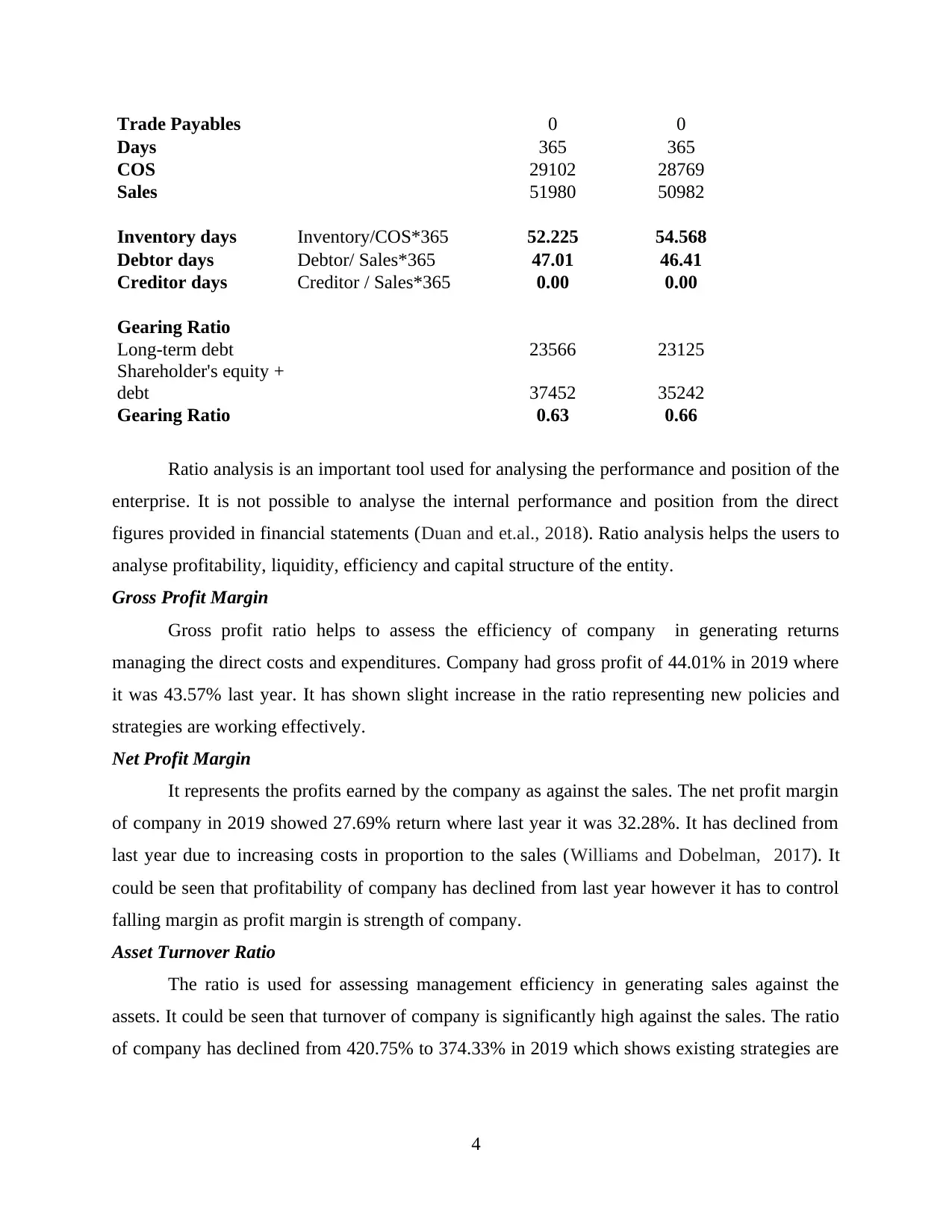
Trade Payables 0 0
Days 365 365
COS 29102 28769
Sales 51980 50982
Inventory days Inventory/COS*365 52.225 54.568
Debtor days Debtor/ Sales*365 47.01 46.41
Creditor days Creditor / Sales*365 0.00 0.00
Gearing Ratio
Long-term debt 23566 23125
Shareholder's equity +
debt 37452 35242
Gearing Ratio 0.63 0.66
Ratio analysis is an important tool used for analysing the performance and position of the
enterprise. It is not possible to analyse the internal performance and position from the direct
figures provided in financial statements (Duan and et.al., 2018). Ratio analysis helps the users to
analyse profitability, liquidity, efficiency and capital structure of the entity.
Gross Profit Margin
Gross profit ratio helps to assess the efficiency of company in generating returns
managing the direct costs and expenditures. Company had gross profit of 44.01% in 2019 where
it was 43.57% last year. It has shown slight increase in the ratio representing new policies and
strategies are working effectively.
Net Profit Margin
It represents the profits earned by the company as against the sales. The net profit margin
of company in 2019 showed 27.69% return where last year it was 32.28%. It has declined from
last year due to increasing costs in proportion to the sales (Williams and Dobelman, 2017). It
could be seen that profitability of company has declined from last year however it has to control
falling margin as profit margin is strength of company.
Asset Turnover Ratio
The ratio is used for assessing management efficiency in generating sales against the
assets. It could be seen that turnover of company is significantly high against the sales. The ratio
of company has declined from 420.75% to 374.33% in 2019 which shows existing strategies are
4
Days 365 365
COS 29102 28769
Sales 51980 50982
Inventory days Inventory/COS*365 52.225 54.568
Debtor days Debtor/ Sales*365 47.01 46.41
Creditor days Creditor / Sales*365 0.00 0.00
Gearing Ratio
Long-term debt 23566 23125
Shareholder's equity +
debt 37452 35242
Gearing Ratio 0.63 0.66
Ratio analysis is an important tool used for analysing the performance and position of the
enterprise. It is not possible to analyse the internal performance and position from the direct
figures provided in financial statements (Duan and et.al., 2018). Ratio analysis helps the users to
analyse profitability, liquidity, efficiency and capital structure of the entity.
Gross Profit Margin
Gross profit ratio helps to assess the efficiency of company in generating returns
managing the direct costs and expenditures. Company had gross profit of 44.01% in 2019 where
it was 43.57% last year. It has shown slight increase in the ratio representing new policies and
strategies are working effectively.
Net Profit Margin
It represents the profits earned by the company as against the sales. The net profit margin
of company in 2019 showed 27.69% return where last year it was 32.28%. It has declined from
last year due to increasing costs in proportion to the sales (Williams and Dobelman, 2017). It
could be seen that profitability of company has declined from last year however it has to control
falling margin as profit margin is strength of company.
Asset Turnover Ratio
The ratio is used for assessing management efficiency in generating sales against the
assets. It could be seen that turnover of company is significantly high against the sales. The ratio
of company has declined from 420.75% to 374.33% in 2019 which shows existing strategies are
4
⊘ This is a preview!⊘
Do you want full access?
Subscribe today to unlock all pages.

Trusted by 1+ million students worldwide
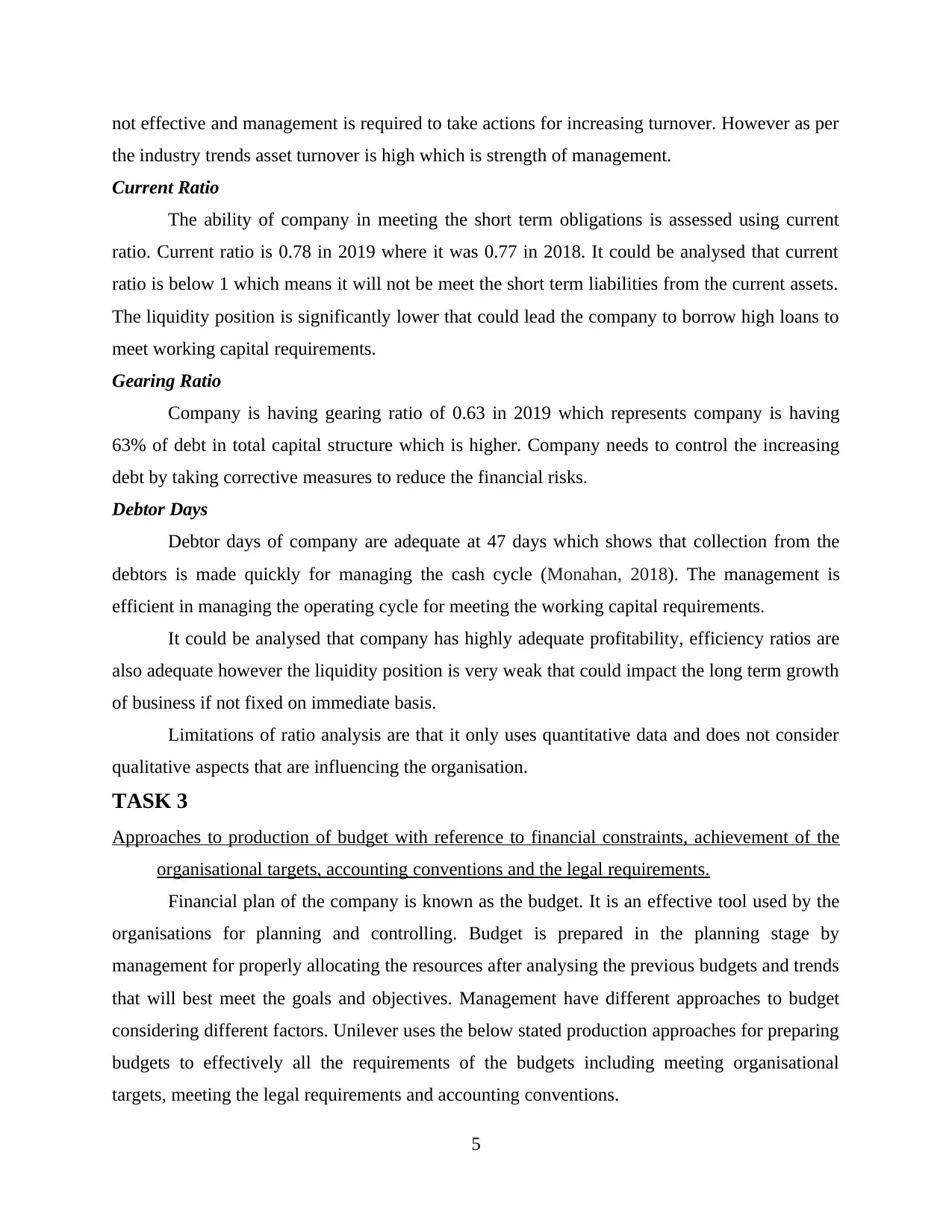
not effective and management is required to take actions for increasing turnover. However as per
the industry trends asset turnover is high which is strength of management.
Current Ratio
The ability of company in meeting the short term obligations is assessed using current
ratio. Current ratio is 0.78 in 2019 where it was 0.77 in 2018. It could be analysed that current
ratio is below 1 which means it will not be meet the short term liabilities from the current assets.
The liquidity position is significantly lower that could lead the company to borrow high loans to
meet working capital requirements.
Gearing Ratio
Company is having gearing ratio of 0.63 in 2019 which represents company is having
63% of debt in total capital structure which is higher. Company needs to control the increasing
debt by taking corrective measures to reduce the financial risks.
Debtor Days
Debtor days of company are adequate at 47 days which shows that collection from the
debtors is made quickly for managing the cash cycle (Monahan, 2018). The management is
efficient in managing the operating cycle for meeting the working capital requirements.
It could be analysed that company has highly adequate profitability, efficiency ratios are
also adequate however the liquidity position is very weak that could impact the long term growth
of business if not fixed on immediate basis.
Limitations of ratio analysis are that it only uses quantitative data and does not consider
qualitative aspects that are influencing the organisation.
TASK 3
Approaches to production of budget with reference to financial constraints, achievement of the
organisational targets, accounting conventions and the legal requirements.
Financial plan of the company is known as the budget. It is an effective tool used by the
organisations for planning and controlling. Budget is prepared in the planning stage by
management for properly allocating the resources after analysing the previous budgets and trends
that will best meet the goals and objectives. Management have different approaches to budget
considering different factors. Unilever uses the below stated production approaches for preparing
budgets to effectively all the requirements of the budgets including meeting organisational
targets, meeting the legal requirements and accounting conventions.
5
the industry trends asset turnover is high which is strength of management.
Current Ratio
The ability of company in meeting the short term obligations is assessed using current
ratio. Current ratio is 0.78 in 2019 where it was 0.77 in 2018. It could be analysed that current
ratio is below 1 which means it will not be meet the short term liabilities from the current assets.
The liquidity position is significantly lower that could lead the company to borrow high loans to
meet working capital requirements.
Gearing Ratio
Company is having gearing ratio of 0.63 in 2019 which represents company is having
63% of debt in total capital structure which is higher. Company needs to control the increasing
debt by taking corrective measures to reduce the financial risks.
Debtor Days
Debtor days of company are adequate at 47 days which shows that collection from the
debtors is made quickly for managing the cash cycle (Monahan, 2018). The management is
efficient in managing the operating cycle for meeting the working capital requirements.
It could be analysed that company has highly adequate profitability, efficiency ratios are
also adequate however the liquidity position is very weak that could impact the long term growth
of business if not fixed on immediate basis.
Limitations of ratio analysis are that it only uses quantitative data and does not consider
qualitative aspects that are influencing the organisation.
TASK 3
Approaches to production of budget with reference to financial constraints, achievement of the
organisational targets, accounting conventions and the legal requirements.
Financial plan of the company is known as the budget. It is an effective tool used by the
organisations for planning and controlling. Budget is prepared in the planning stage by
management for properly allocating the resources after analysing the previous budgets and trends
that will best meet the goals and objectives. Management have different approaches to budget
considering different factors. Unilever uses the below stated production approaches for preparing
budgets to effectively all the requirements of the budgets including meeting organisational
targets, meeting the legal requirements and accounting conventions.
5
Paraphrase This Document
Need a fresh take? Get an instant paraphrase of this document with our AI Paraphraser
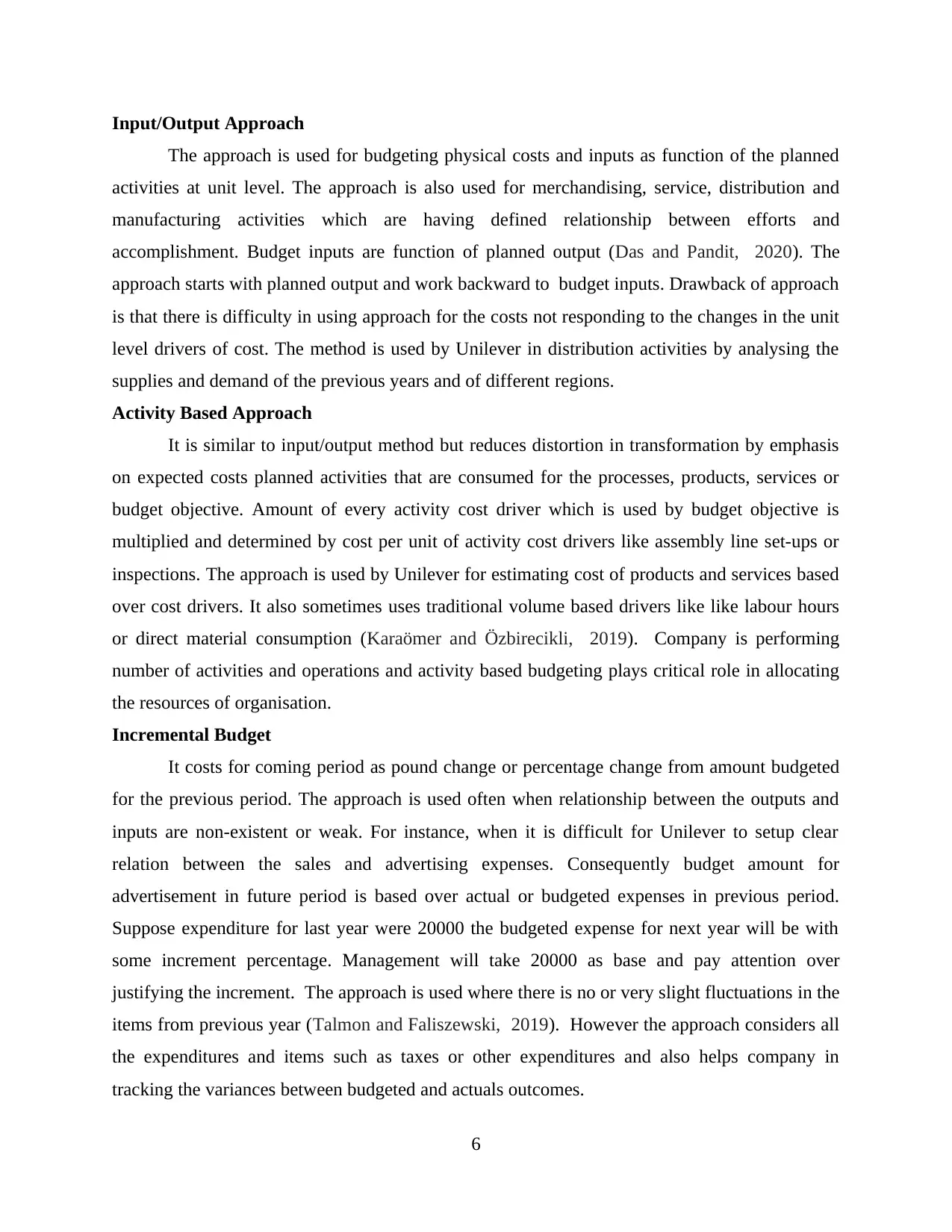
Input/Output Approach
The approach is used for budgeting physical costs and inputs as function of the planned
activities at unit level. The approach is also used for merchandising, service, distribution and
manufacturing activities which are having defined relationship between efforts and
accomplishment. Budget inputs are function of planned output (Das and Pandit, 2020). The
approach starts with planned output and work backward to budget inputs. Drawback of approach
is that there is difficulty in using approach for the costs not responding to the changes in the unit
level drivers of cost. The method is used by Unilever in distribution activities by analysing the
supplies and demand of the previous years and of different regions.
Activity Based Approach
It is similar to input/output method but reduces distortion in transformation by emphasis
on expected costs planned activities that are consumed for the processes, products, services or
budget objective. Amount of every activity cost driver which is used by budget objective is
multiplied and determined by cost per unit of activity cost drivers like assembly line set-ups or
inspections. The approach is used by Unilever for estimating cost of products and services based
over cost drivers. It also sometimes uses traditional volume based drivers like like labour hours
or direct material consumption (Karaömer and Özbirecikli, 2019). Company is performing
number of activities and operations and activity based budgeting plays critical role in allocating
the resources of organisation.
Incremental Budget
It costs for coming period as pound change or percentage change from amount budgeted
for the previous period. The approach is used often when relationship between the outputs and
inputs are non-existent or weak. For instance, when it is difficult for Unilever to setup clear
relation between the sales and advertising expenses. Consequently budget amount for
advertisement in future period is based over actual or budgeted expenses in previous period.
Suppose expenditure for last year were 20000 the budgeted expense for next year will be with
some increment percentage. Management will take 20000 as base and pay attention over
justifying the increment. The approach is used where there is no or very slight fluctuations in the
items from previous year (Talmon and Faliszewski, 2019). However the approach considers all
the expenditures and items such as taxes or other expenditures and also helps company in
tracking the variances between budgeted and actuals outcomes.
6
The approach is used for budgeting physical costs and inputs as function of the planned
activities at unit level. The approach is also used for merchandising, service, distribution and
manufacturing activities which are having defined relationship between efforts and
accomplishment. Budget inputs are function of planned output (Das and Pandit, 2020). The
approach starts with planned output and work backward to budget inputs. Drawback of approach
is that there is difficulty in using approach for the costs not responding to the changes in the unit
level drivers of cost. The method is used by Unilever in distribution activities by analysing the
supplies and demand of the previous years and of different regions.
Activity Based Approach
It is similar to input/output method but reduces distortion in transformation by emphasis
on expected costs planned activities that are consumed for the processes, products, services or
budget objective. Amount of every activity cost driver which is used by budget objective is
multiplied and determined by cost per unit of activity cost drivers like assembly line set-ups or
inspections. The approach is used by Unilever for estimating cost of products and services based
over cost drivers. It also sometimes uses traditional volume based drivers like like labour hours
or direct material consumption (Karaömer and Özbirecikli, 2019). Company is performing
number of activities and operations and activity based budgeting plays critical role in allocating
the resources of organisation.
Incremental Budget
It costs for coming period as pound change or percentage change from amount budgeted
for the previous period. The approach is used often when relationship between the outputs and
inputs are non-existent or weak. For instance, when it is difficult for Unilever to setup clear
relation between the sales and advertising expenses. Consequently budget amount for
advertisement in future period is based over actual or budgeted expenses in previous period.
Suppose expenditure for last year were 20000 the budgeted expense for next year will be with
some increment percentage. Management will take 20000 as base and pay attention over
justifying the increment. The approach is used where there is no or very slight fluctuations in the
items from previous year (Talmon and Faliszewski, 2019). However the approach considers all
the expenditures and items such as taxes or other expenditures and also helps company in
tracking the variances between budgeted and actuals outcomes.
6
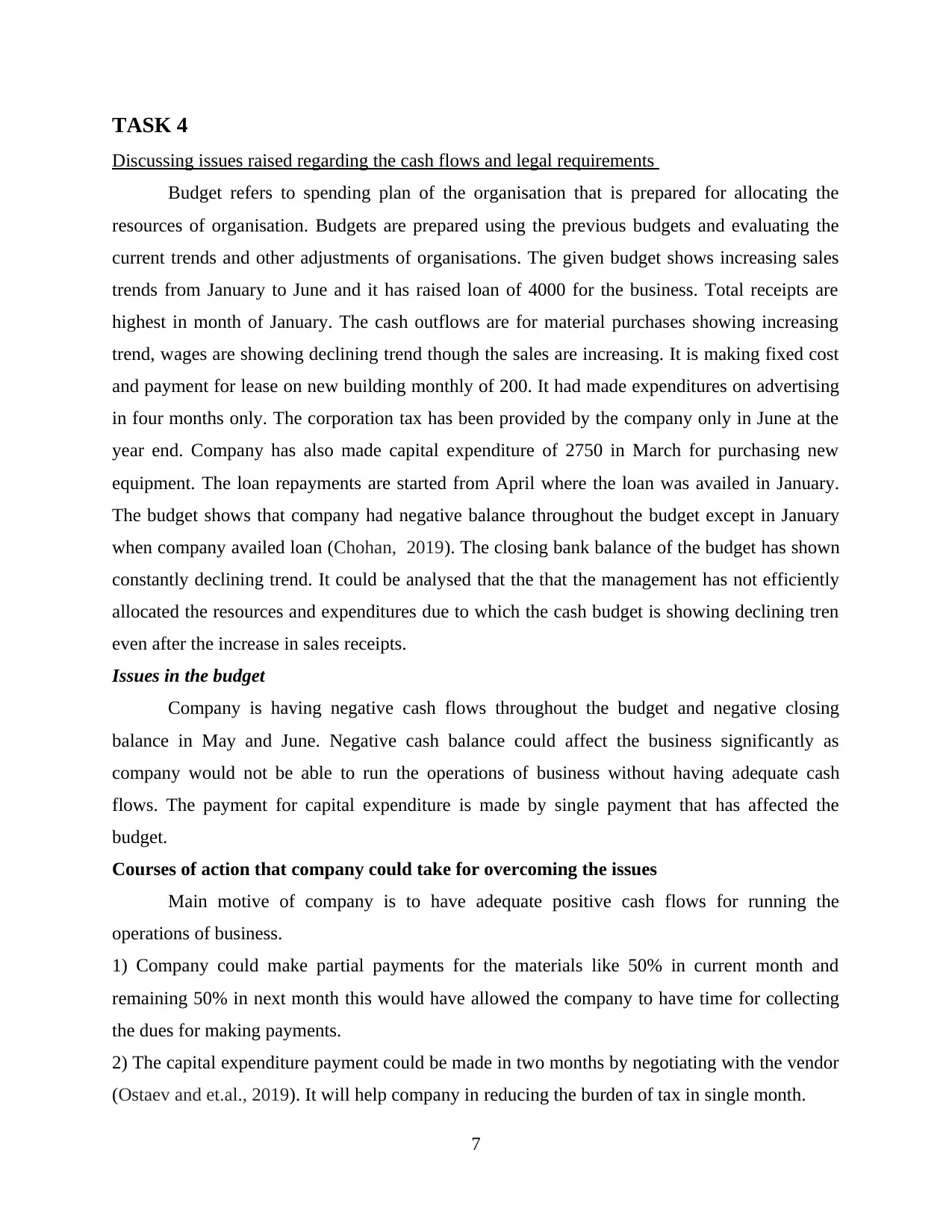
TASK 4
Discussing issues raised regarding the cash flows and legal requirements
Budget refers to spending plan of the organisation that is prepared for allocating the
resources of organisation. Budgets are prepared using the previous budgets and evaluating the
current trends and other adjustments of organisations. The given budget shows increasing sales
trends from January to June and it has raised loan of 4000 for the business. Total receipts are
highest in month of January. The cash outflows are for material purchases showing increasing
trend, wages are showing declining trend though the sales are increasing. It is making fixed cost
and payment for lease on new building monthly of 200. It had made expenditures on advertising
in four months only. The corporation tax has been provided by the company only in June at the
year end. Company has also made capital expenditure of 2750 in March for purchasing new
equipment. The loan repayments are started from April where the loan was availed in January.
The budget shows that company had negative balance throughout the budget except in January
when company availed loan (Chohan, 2019). The closing bank balance of the budget has shown
constantly declining trend. It could be analysed that the that the management has not efficiently
allocated the resources and expenditures due to which the cash budget is showing declining tren
even after the increase in sales receipts.
Issues in the budget
Company is having negative cash flows throughout the budget and negative closing
balance in May and June. Negative cash balance could affect the business significantly as
company would not be able to run the operations of business without having adequate cash
flows. The payment for capital expenditure is made by single payment that has affected the
budget.
Courses of action that company could take for overcoming the issues
Main motive of company is to have adequate positive cash flows for running the
operations of business.
1) Company could make partial payments for the materials like 50% in current month and
remaining 50% in next month this would have allowed the company to have time for collecting
the dues for making payments.
2) The capital expenditure payment could be made in two months by negotiating with the vendor
(Ostaev and et.al., 2019). It will help company in reducing the burden of tax in single month.
7
Discussing issues raised regarding the cash flows and legal requirements
Budget refers to spending plan of the organisation that is prepared for allocating the
resources of organisation. Budgets are prepared using the previous budgets and evaluating the
current trends and other adjustments of organisations. The given budget shows increasing sales
trends from January to June and it has raised loan of 4000 for the business. Total receipts are
highest in month of January. The cash outflows are for material purchases showing increasing
trend, wages are showing declining trend though the sales are increasing. It is making fixed cost
and payment for lease on new building monthly of 200. It had made expenditures on advertising
in four months only. The corporation tax has been provided by the company only in June at the
year end. Company has also made capital expenditure of 2750 in March for purchasing new
equipment. The loan repayments are started from April where the loan was availed in January.
The budget shows that company had negative balance throughout the budget except in January
when company availed loan (Chohan, 2019). The closing bank balance of the budget has shown
constantly declining trend. It could be analysed that the that the management has not efficiently
allocated the resources and expenditures due to which the cash budget is showing declining tren
even after the increase in sales receipts.
Issues in the budget
Company is having negative cash flows throughout the budget and negative closing
balance in May and June. Negative cash balance could affect the business significantly as
company would not be able to run the operations of business without having adequate cash
flows. The payment for capital expenditure is made by single payment that has affected the
budget.
Courses of action that company could take for overcoming the issues
Main motive of company is to have adequate positive cash flows for running the
operations of business.
1) Company could make partial payments for the materials like 50% in current month and
remaining 50% in next month this would have allowed the company to have time for collecting
the dues for making payments.
2) The capital expenditure payment could be made in two months by negotiating with the vendor
(Ostaev and et.al., 2019). It will help company in reducing the burden of tax in single month.
7
⊘ This is a preview!⊘
Do you want full access?
Subscribe today to unlock all pages.

Trusted by 1+ million students worldwide
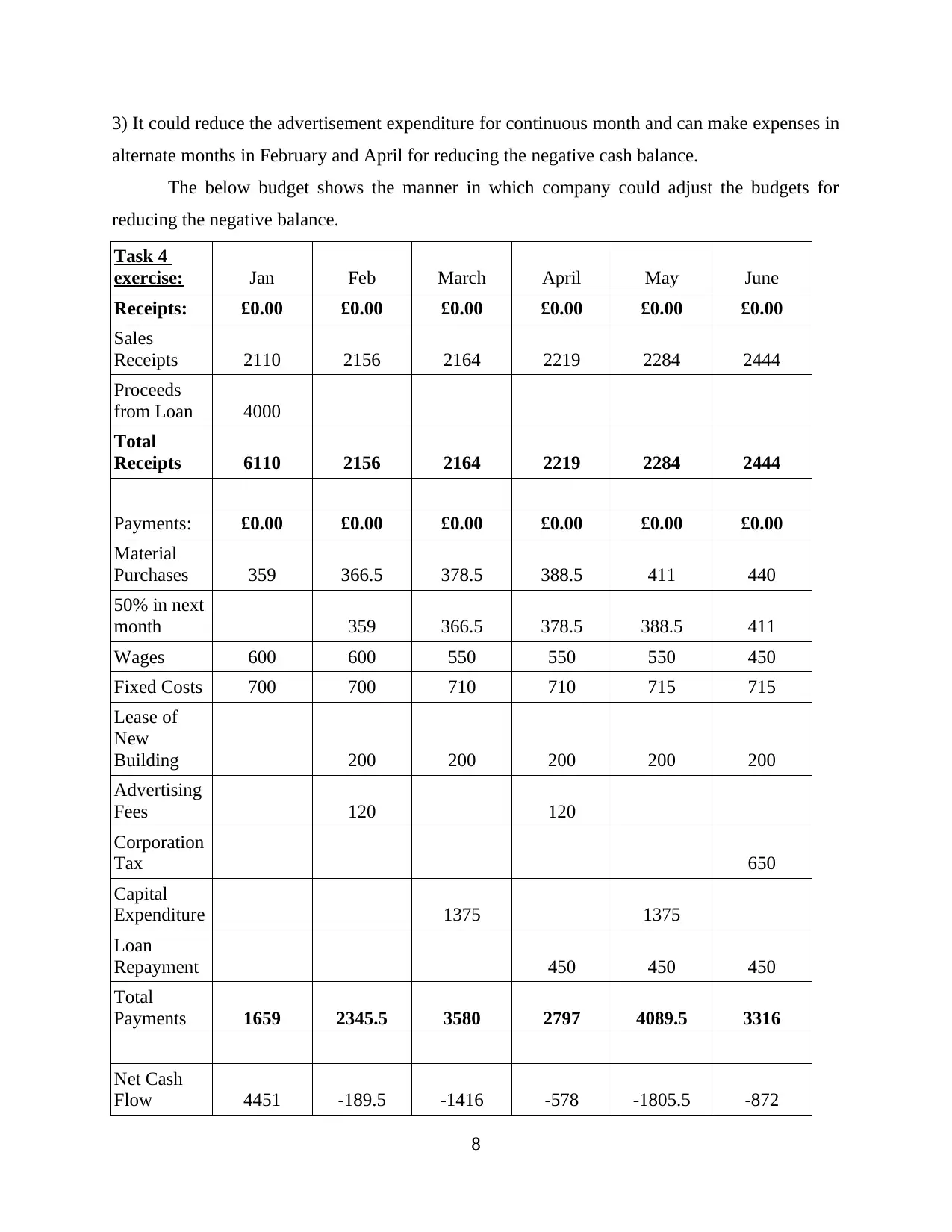
3) It could reduce the advertisement expenditure for continuous month and can make expenses in
alternate months in February and April for reducing the negative cash balance.
The below budget shows the manner in which company could adjust the budgets for
reducing the negative balance.
Task 4
exercise: Jan Feb March April May June
Receipts: £0.00 £0.00 £0.00 £0.00 £0.00 £0.00
Sales
Receipts 2110 2156 2164 2219 2284 2444
Proceeds
from Loan 4000
Total
Receipts 6110 2156 2164 2219 2284 2444
Payments: £0.00 £0.00 £0.00 £0.00 £0.00 £0.00
Material
Purchases 359 366.5 378.5 388.5 411 440
50% in next
month 359 366.5 378.5 388.5 411
Wages 600 600 550 550 550 450
Fixed Costs 700 700 710 710 715 715
Lease of
New
Building 200 200 200 200 200
Advertising
Fees 120 120
Corporation
Tax 650
Capital
Expenditure 1375 1375
Loan
Repayment 450 450 450
Total
Payments 1659 2345.5 3580 2797 4089.5 3316
Net Cash
Flow 4451 -189.5 -1416 -578 -1805.5 -872
8
alternate months in February and April for reducing the negative cash balance.
The below budget shows the manner in which company could adjust the budgets for
reducing the negative balance.
Task 4
exercise: Jan Feb March April May June
Receipts: £0.00 £0.00 £0.00 £0.00 £0.00 £0.00
Sales
Receipts 2110 2156 2164 2219 2284 2444
Proceeds
from Loan 4000
Total
Receipts 6110 2156 2164 2219 2284 2444
Payments: £0.00 £0.00 £0.00 £0.00 £0.00 £0.00
Material
Purchases 359 366.5 378.5 388.5 411 440
50% in next
month 359 366.5 378.5 388.5 411
Wages 600 600 550 550 550 450
Fixed Costs 700 700 710 710 715 715
Lease of
New
Building 200 200 200 200 200
Advertising
Fees 120 120
Corporation
Tax 650
Capital
Expenditure 1375 1375
Loan
Repayment 450 450 450
Total
Payments 1659 2345.5 3580 2797 4089.5 3316
Net Cash
Flow 4451 -189.5 -1416 -578 -1805.5 -872
8
Paraphrase This Document
Need a fresh take? Get an instant paraphrase of this document with our AI Paraphraser
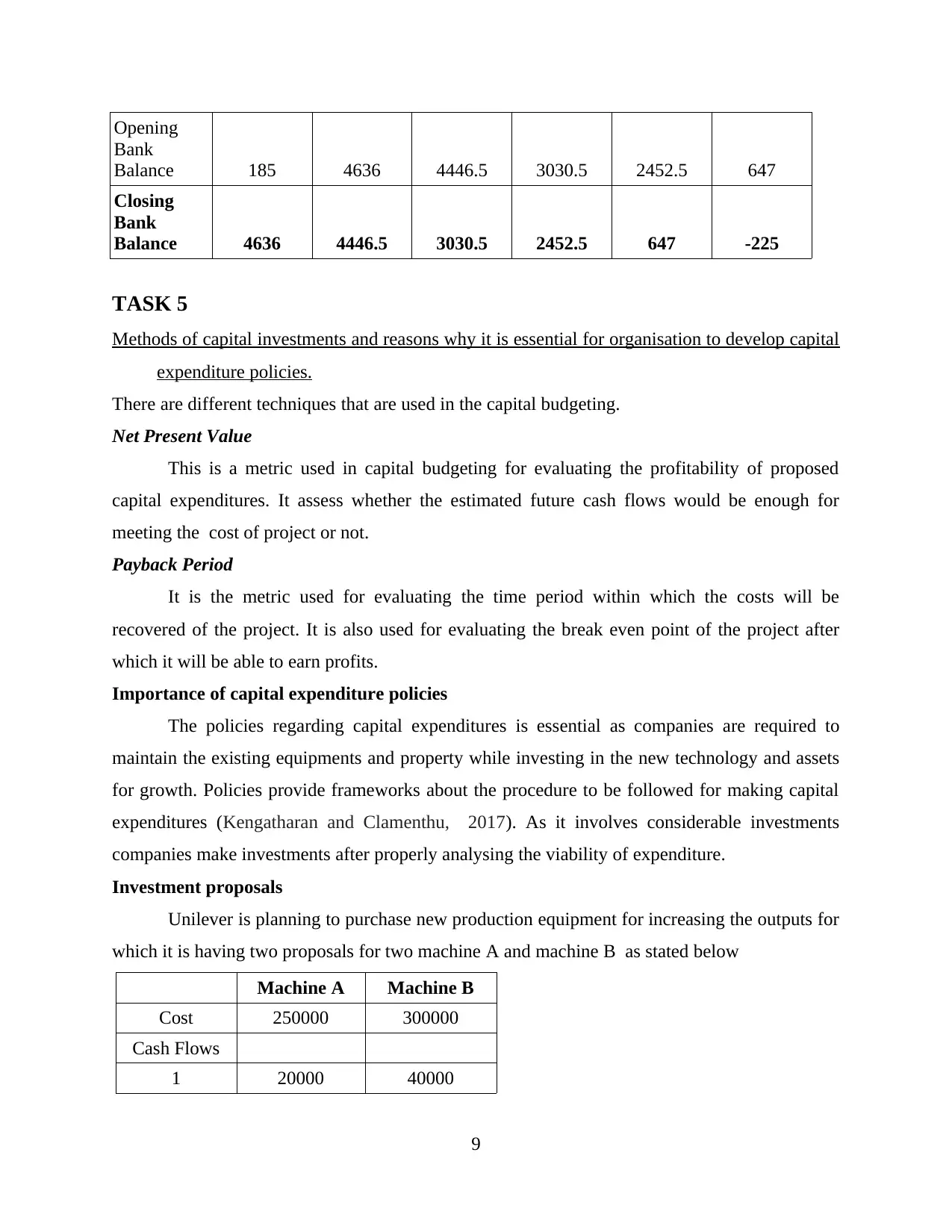
Opening
Bank
Balance 185 4636 4446.5 3030.5 2452.5 647
Closing
Bank
Balance 4636 4446.5 3030.5 2452.5 647 -225
TASK 5
Methods of capital investments and reasons why it is essential for organisation to develop capital
expenditure policies.
There are different techniques that are used in the capital budgeting.
Net Present Value
This is a metric used in capital budgeting for evaluating the profitability of proposed
capital expenditures. It assess whether the estimated future cash flows would be enough for
meeting the cost of project or not.
Payback Period
It is the metric used for evaluating the time period within which the costs will be
recovered of the project. It is also used for evaluating the break even point of the project after
which it will be able to earn profits.
Importance of capital expenditure policies
The policies regarding capital expenditures is essential as companies are required to
maintain the existing equipments and property while investing in the new technology and assets
for growth. Policies provide frameworks about the procedure to be followed for making capital
expenditures (Kengatharan and Clamenthu, 2017). As it involves considerable investments
companies make investments after properly analysing the viability of expenditure.
Investment proposals
Unilever is planning to purchase new production equipment for increasing the outputs for
which it is having two proposals for two machine A and machine B as stated below
Machine A Machine B
Cost 250000 300000
Cash Flows
1 20000 40000
9
Bank
Balance 185 4636 4446.5 3030.5 2452.5 647
Closing
Bank
Balance 4636 4446.5 3030.5 2452.5 647 -225
TASK 5
Methods of capital investments and reasons why it is essential for organisation to develop capital
expenditure policies.
There are different techniques that are used in the capital budgeting.
Net Present Value
This is a metric used in capital budgeting for evaluating the profitability of proposed
capital expenditures. It assess whether the estimated future cash flows would be enough for
meeting the cost of project or not.
Payback Period
It is the metric used for evaluating the time period within which the costs will be
recovered of the project. It is also used for evaluating the break even point of the project after
which it will be able to earn profits.
Importance of capital expenditure policies
The policies regarding capital expenditures is essential as companies are required to
maintain the existing equipments and property while investing in the new technology and assets
for growth. Policies provide frameworks about the procedure to be followed for making capital
expenditures (Kengatharan and Clamenthu, 2017). As it involves considerable investments
companies make investments after properly analysing the viability of expenditure.
Investment proposals
Unilever is planning to purchase new production equipment for increasing the outputs for
which it is having two proposals for two machine A and machine B as stated below
Machine A Machine B
Cost 250000 300000
Cash Flows
1 20000 40000
9
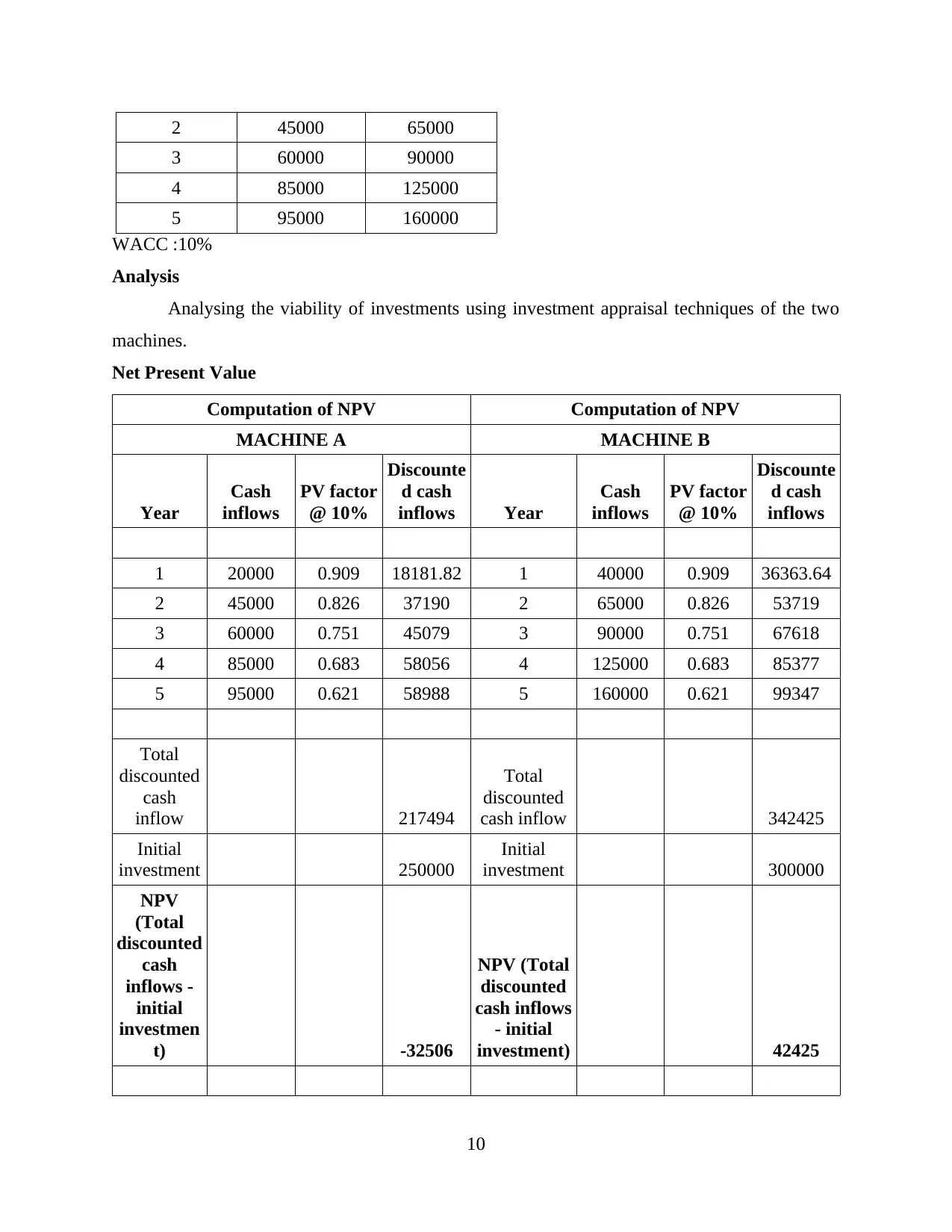
2 45000 65000
3 60000 90000
4 85000 125000
5 95000 160000
WACC :10%
Analysis
Analysing the viability of investments using investment appraisal techniques of the two
machines.
Net Present Value
Computation of NPV Computation of NPV
MACHINE A MACHINE B
Year
Cash
inflows
PV factor
@ 10%
Discounte
d cash
inflows Year
Cash
inflows
PV factor
@ 10%
Discounte
d cash
inflows
1 20000 0.909 18181.82 1 40000 0.909 36363.64
2 45000 0.826 37190 2 65000 0.826 53719
3 60000 0.751 45079 3 90000 0.751 67618
4 85000 0.683 58056 4 125000 0.683 85377
5 95000 0.621 58988 5 160000 0.621 99347
Total
discounted
cash
inflow 217494
Total
discounted
cash inflow 342425
Initial
investment 250000
Initial
investment 300000
NPV
(Total
discounted
cash
inflows -
initial
investmen
t) -32506
NPV (Total
discounted
cash inflows
- initial
investment) 42425
10
3 60000 90000
4 85000 125000
5 95000 160000
WACC :10%
Analysis
Analysing the viability of investments using investment appraisal techniques of the two
machines.
Net Present Value
Computation of NPV Computation of NPV
MACHINE A MACHINE B
Year
Cash
inflows
PV factor
@ 10%
Discounte
d cash
inflows Year
Cash
inflows
PV factor
@ 10%
Discounte
d cash
inflows
1 20000 0.909 18181.82 1 40000 0.909 36363.64
2 45000 0.826 37190 2 65000 0.826 53719
3 60000 0.751 45079 3 90000 0.751 67618
4 85000 0.683 58056 4 125000 0.683 85377
5 95000 0.621 58988 5 160000 0.621 99347
Total
discounted
cash
inflow 217494
Total
discounted
cash inflow 342425
Initial
investment 250000
Initial
investment 300000
NPV
(Total
discounted
cash
inflows -
initial
investmen
t) -32506
NPV (Total
discounted
cash inflows
- initial
investment) 42425
10
⊘ This is a preview!⊘
Do you want full access?
Subscribe today to unlock all pages.

Trusted by 1+ million students worldwide
1 out of 15
Related Documents
Your All-in-One AI-Powered Toolkit for Academic Success.
+13062052269
info@desklib.com
Available 24*7 on WhatsApp / Email
![[object Object]](/_next/static/media/star-bottom.7253800d.svg)
Unlock your academic potential
Copyright © 2020–2025 A2Z Services. All Rights Reserved. Developed and managed by ZUCOL.





